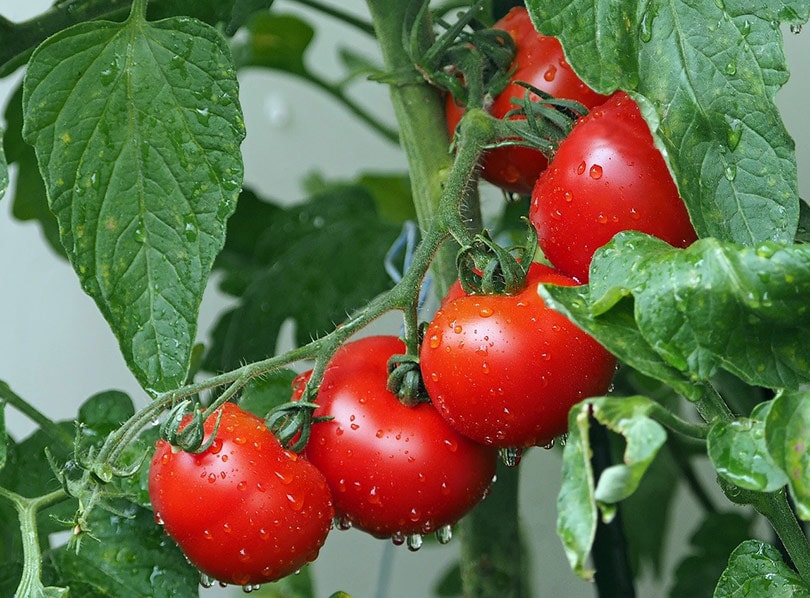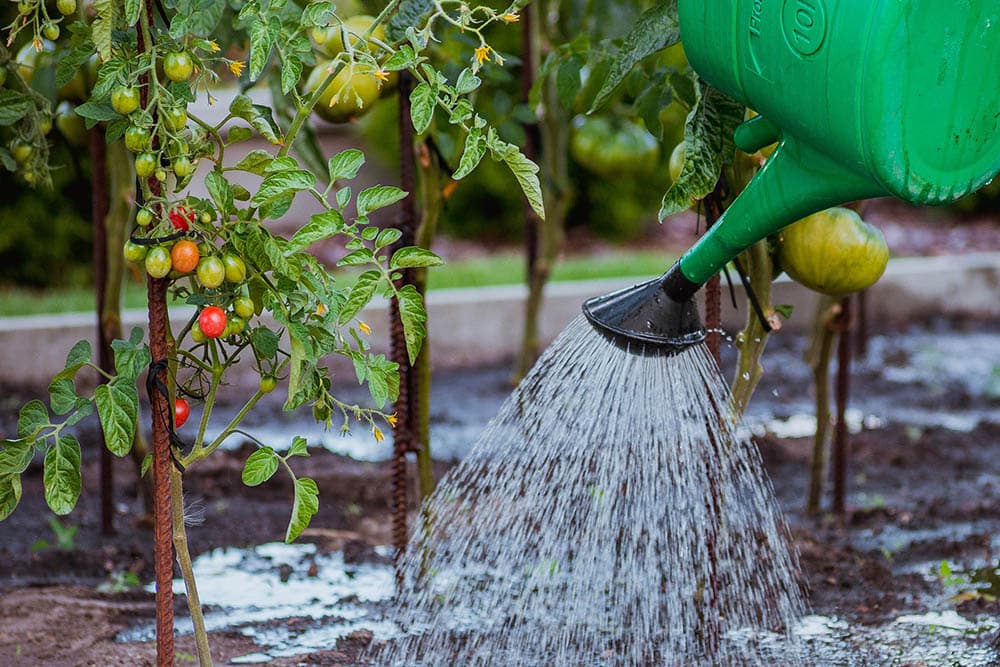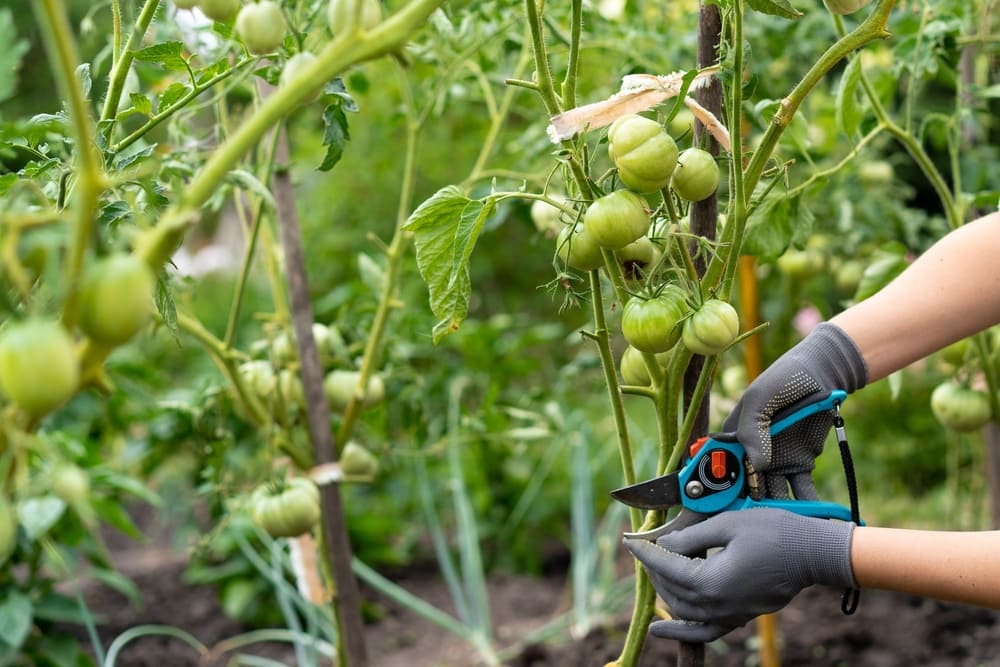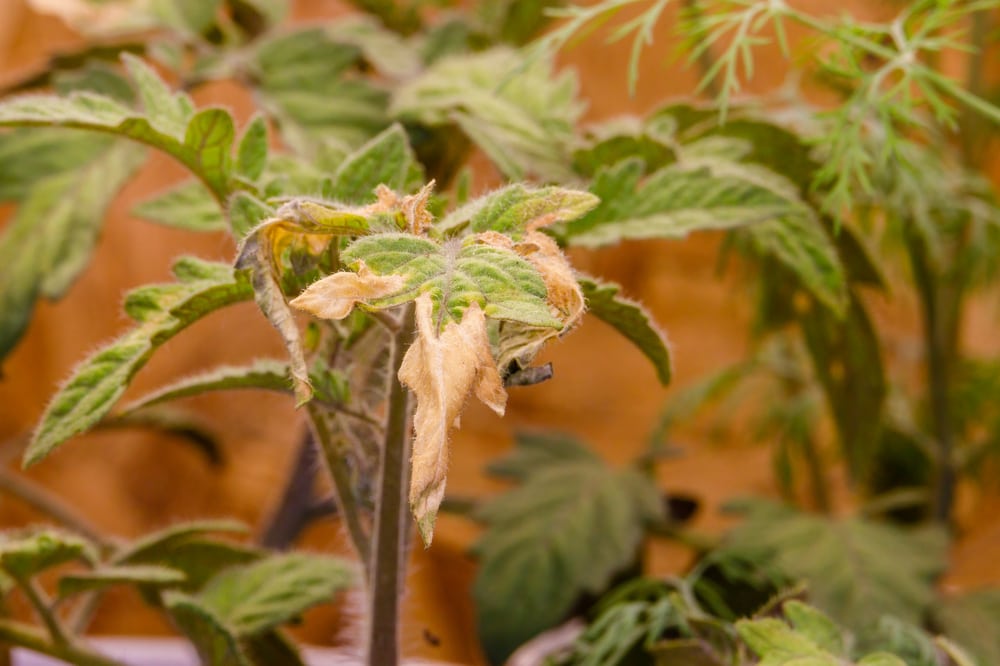Why Tomato Plant Leaves Curl: 9 Reasons & Fixes
-

- Last updated:

Whether you are new to gardening or are a pro, one problem that you are bound to experience at some point is your tomato plant leaves curling. But what does it mean, how does it affect the yield, and most importantly, what do you do about it?
The good news is that it’s typically easy to take care of, and once you address and remedy the root cause, your plant should rebound quickly.
But first, you need to figure out what’s causing the problem. This way, you know the right steps to fix it. Here, we highlighted the nine most common reasons that tomato plant leaves curl and what you should do for each situation.
Top 9 Reasons Why Tomato Plant Leaves Curl
1. Incorrect Water Application

While tomatoes are generally forgiving plants, you can both overwater and underwater them. Aim for about 2 inches of water per week for optimal growth. While you can’t always control the amount of rainfall in a week, do your best to avoid watering them during heavy rainfall periods, and always ensure that you water them during extended periods with no rain.
It is also the key to remedying the situation. If the tomatoes are overwatered, let them dry out a bit, and if they don’t have enough water, go add more! The good news is that it doesn’t take long for tomato plants to rebound from this situation.
2. Excessive Heat
While tomato plants are hot-weather plants, too much heat can still be a problem. In most areas, this is only a problem during incremental heat waves, so when the heat wave breaks, the tomato plants should go right back to thriving.
While you can’t necessarily remove heat, one of the best ways that you can help your tomato plants during excessively hot periods is to water them more. The soil will dry out quicker during hotter weather, so you’ll need to water more frequently to help your tomato plants thrive.
3. Too Much Wind
Tomato plants can handle typical wind levels with ease, but when the wind starts to ratchet up, it can create problems. If you live in an area susceptible to high winds, we recommend installing some sort of windbreaker to divert the wind away. Just ensure that there’s plenty of space above the breakers for both sunlight and water to continue to reach the plants.
4. Excessive Pruning

There’s a great deal of debate on whether you should prune tomato plants at all, but there’s no debate about whether you can overdo it. Excessive pruning stresses out the plant, and when this happens, it leads to curling or wilting leaves.
To fix the problem, simply stop pruning the plant. Once it fully recovers, you can prune a few of the vines a bit, but don’t do as much as you were before.
5. Too Much Herbicide
Herbicides are extremely common to use to control weeds and other problems, but tomato plants don’t do well with them. Even if you’re not directly applying herbicides to your garden, though, you might have a problem.
Many herbicides that people use for grass are susceptible to being over-sprayed. Even fine particles of the herbicide reaching the tomato plant can lead to problems.
Once you have an affected tomato plant, all you can do is continue to water the plant and try to help it through, but you’ll likely experience a diminished crop. In future years, consider putting breakers around the garden to help prevent herbicides from reaching the plants.
6. Pest Damage
Humans are not the only ones who like the taste of tomatoes. Tomato plants are susceptible to pests, like tomato pinworms, that can stress out your plants.
If you want your tomato plants to recover, you need to identify the pest attacking your garden and use the appropriate treatment to get rid of them.
7. Excessive Nitrogen

Your tomato plants need nitrogen, but many novice gardeners pack too much into the soil. Signs of excessive nitrogen in the soil include curling leaves, but you’ll also likely notice that they’re a brighter shade of green than they should be.
Once there’s too much nitrogen in the soil, all you can do is let the crops use it up. Don’t add any more fertilizer. Test the soil next year to see if you should add more nitrogen at that point.
8. Transplant Shock
Moving your plant from one container to another is a stressful event for your garden. It’s completely normal for the leaves to curl a bit during this time. The good news is that if this is all your plant is going through, they almost always recover.
Water them appropriately, and ensure that they get adequate sunlight and not too much wind. In short, reduce the number of external stressors for the plants while they adjust to the new environment.
9. Disease
This is by far the worst-case scenario for your garden. If the leaves of your tomato plant are curling, yellowing, and turning up instead of down, there’s a good chance that you’re dealing with a tomato plant disease.
Unfortunately, there’s no saving a tomato plant with a disease. Worse, if you don’t address it quickly, it can spread throughout your entire garden and wipe everything else out. If you have a diseased tomato plant, remove it immediately and destroy it so it can’t spread the disease anywhere else.
The good news is that tomato plant diseases are relatively rare.
Final Thoughts
Dealing with curling leaves and other plant problems is just a part of the gardening experience, and soon, you’ll know just how to fix each problem. So, take a look at everything going on with your tomato plant, and we’re confident that with the guidance from this list, you’ll be able to figure out what’s going on.
Once you do, you’ll know exactly what you need to do to fix it and keep it from happening again in the future!
Featured Image Credit: kie-ker, Pixabay
Contents

